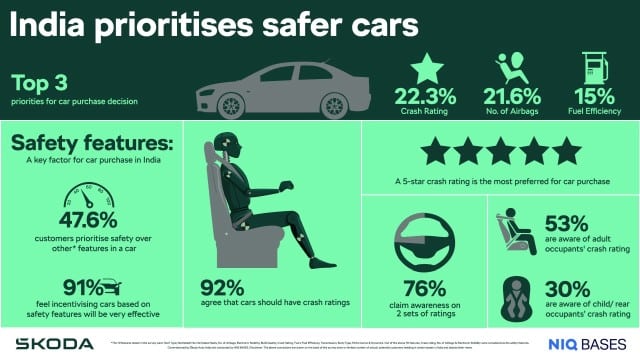In the latest study conducted recently, it was revealed that nine out of 10 customers in India want cars with a safety rating.

The survey was commissioned by Škoda Auto India and conducted by NIQ BASES. The results were interesting to say the least. Here’s the low-down:
- 92% customers want cars in India to be crash-tested and given a safety rating.
- 47.6% customers prioritise safety over other features in a car.
- Crash-rating tops list of priorities for car purchase decision.
- Fuel efficiency takes third place for car purchase decision.
- 91% feel incentivising cars based on safety features will be very effective.
- Only 30% of all customers are aware of separate child/rear occupants safety rating.
- A 5-star crash rating is the most preferred for car purchase.
The study was conducted among customers to gauge their feature preferences when it comes to choosing a personal car. The survey revealed a heavy inclination amongst customers towards the safety features of the car with 90% of the customers thinking that all cars in India should have a safety rating. Crash-ratings and number of airbags were the top two features driving the consumer car purchase decision as derived from the survey results. Fuel-efficiency, one of the aspects perceived as most popular, was in third place.
The car’s crash rating was the top driver of customer car purchase decision with an importance score of 22.3% followed by number of airbags with an importance score of 21.6%. Fuel efficiency emerged as the third most important driver with importance score of 15% when purchasing a car.
When it comes to crash rating for cars, the maximum customer preference of 22.2% was observed for a “5-star” rating followed closely by 21.3% preference for a “4-star” rating. Crash rating of zero is the least preferred with only 6.8% score.
About two-thirds (67%) of the respondents consisted of current car owners who owned a car above Rs 5 lakh. A third (33%) did not own a car, but intended to purchase one above Rs 5 lakh within a year. The survey was conducted on individuals between 18 and 54 years of age in the “SEC A and B” bracket, with 80% respondents being male, and 20% female.




















Leave a Reply